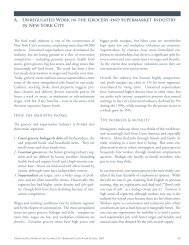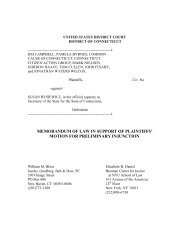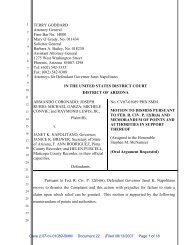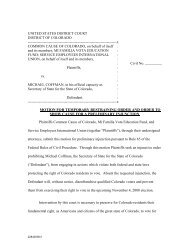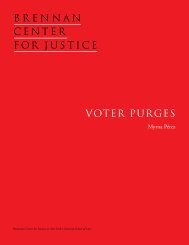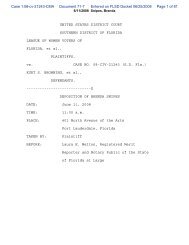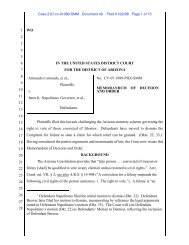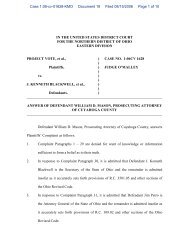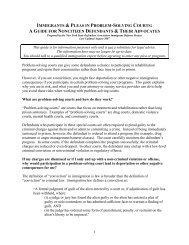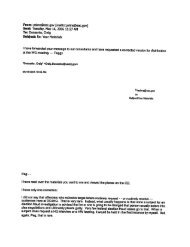concerns when a defendant lacks the charmof a Muppet. The pornographic movie DebbieDoes Dallas was found to cause confusionbecause it used the trademarked costumes of theDallas Cowboys cheerleaders. (The court’s biaswas apparent in its description of the movie’s“gross and revolting” content. 83 ) On the otherhand, New York magazine’s use of trademarkedelements of the Old Farmers Almanac in asexually tinged Christmas issue was held not tocreate any serious confusion. The court foundnot only that the magazine “made it sufficientlyclear” that the reference to the Almanac was ajoke, but that New York’s First Amendmentright “of commentary and artistic expression”outweighed any harm to the Almanac that mightarise “even if there was some confusion as tosource or origin.” 84Trademark law also has two fair use defenses,but they are narrower and more specific thanthe freewheeling fair use factors of copyright.The first, “classic” or “descriptive” fair use,occurs when a phrase or image is used simplyto describe, rather than to identify, a productTrademark law also hastwo fair use defenses, butthey are narrower andmore specific than thefreewheeling fair use factorsof copyright.– for example, describing a cereal other than“Kellogg’s All Bran” as consisting of “all bran,”or describing a fish batter with words similar tothe trademarked “Fish-Fri.” 85The second, or “nominative fair use” defense,arises when a trademark is used to identify aproduct or service, but not to deceive the publicor sow confusion. One way to understandthe difference is that classic fair use occurswhen somebody uses the contested trademarkto describe his own goods or services, andnominative fair use occurs where the mark isused to refer to the goods or services of its owner,as in comparative advertising or appropriationistart.Thus, Tom Forsythe’s “Food Chain Barbies”were nominative fair use. 86 When a formerPlayboy model used the Playboy trademark inpromotional material describing her career,she also qualified for nominative fair use. 87And when New Kids on the Block sued USAToday for using their name in connection witha telephone poll asking readers to identify theirfavorite member of the group, the court said itwas nominative fair use because the paper usedonly as much of the mark as was necessary toidentify the group, and there was no suggestionof sponsorship or endorsement. 88Because these fair use defenses are narrowerthan their copyright law cousin, the FirstAmendment also comes into play in trademarkcases. (In copyright cases, the Supreme Courthas said, no First Amendment scrutiny isneeded unless Congress changes the “traditionalcontours” of the law, which already includesfair use and other free expression safeguards. 89 )Courts confronting First Amendmenttrademarkdilemmas usually balance the owner’s(and public’s) interest in avoiding confusionagainst the rights of artists, satirists, or othercommenters to use the trademarks in makingtheir point. Or, in a variation on this theme,courts apply the “likelihood of confusion” teststringently, in deference to the free speech rightsat stake.So, for example, in two of the many lawsuitsbrought by Mattel to try to stop unauthorizeduses of Barbie – one involving Forsythe’sculinary parodies; the other a rock ’n roll songthat mocked the pulchritudinous doll – theartists’ First Amendment rights weighed heavilyin the balance. 90 Another court found that acomic book parody of bodybuilding ads hadFirst Amendment protection that outweighedthe slim likelihood of confusion with an actualbodybuilding company. 91And when the actress Ginger Rogers sueddistributors of Federico Fellini’s Ginger andFred – a movie about two itinerant cabaretperformers – the court found little likelihood that12 Will Fair Use Survive?
the public would be confused about whetherMs. Rogers sponsored the film, and added that,in any event, whatever confusion there mightbe was outweighed by the First Amendmentright to choose the title for a creative work.The Lanham Act, the courtsaid, should apply to artisticworks “only where the publicinterest in avoiding confusionoutweighs the public interestin free expression.” 92 Quotinga Vietnam War era SupremeCourt case, the judges added:“we cannot indulge thefacile assumption that onecan forbid particular wordswithout running a substantialrisk of suppressing ideas in theprocess.” 93Not all First Amendmentdefenses fare so well. In 1994,Anheuser-Busch won a suitagainst political parodists whoattacked its environmentalrecord with mock advertisementsfeaturing “MichelobOily.” The phony ads concludedwith the remark: “atthe rate it’s being dumpedinto our oceans, lakes and rivers,you’ll drink it oily sooneror later.” Taking a tone-deafapproach to the parody, thejudges emphasized that the defendants“possessed no knowledgethat any Anheuser-Busch product actuallycontained oil.” They dismissed the parodists’ freeexpression defense; then decided there was a seriouslikelihood of confusion based on a surveyconducted in St. Louis shopping malls. 94In 1995, Congress added a new prohibitionto the law: “trademark dilution.” Its purposeis to prevent the weakening of a mark byblurring its “distinctive quality,” or the“tarnishment” of a mark by disparaging it orassociating it with shoddy or unsavory goods.No likelihood of confusion is required. 95 Asapplied to such misleading labels as “Tylenolsnowboards” or “Harry Potter dry cleaners,” 96the ban on trademark dilution presents few freeexpression problems. But applied to politicalcritiques that necessarily “tarnish” a company’sidentifying signs and symbols, it threatens FirstAmendment rights.The dilution law does have free expressionsafeguards: allowances for comparative advertising,news reporting and commentary,and any “noncommercial”use of a mark. Butcourts have sometimes beenslippery about the noncommercialuse exception; onejudge stretched to find thata Web site critical of Jews forJesus was commercial becauseit had impact on the group’scommercial activities. 97On the other hand, the courtin one Barbie Doll case, citingFirst Amendment concerns,read the “noncommercial use”exemption to protect parodiesand other critiques. 98 Anothercourt dismissed a suit by Rev.Jerry Falwell against a criticusing the URL www.fallwell.com, noting that Congress“did not intend for trademarklaws to impinge the FirstAmendment rights of criticsand commentators.” 99Tom Forsythe, “Every Barbie One further amendment tofor Herself”the trademark law goes bythe cumbersome name ofthe Anticybersquatting Consumer ProtectionAct, 100 and prohibits Internet domain namesthat are “identical or confusingly similar”to each other, but only where there is a “badfaith intent to profit” from the confusinglysimilar name. This limitation gives freespeech protection to dissidents who register“thiscompanysucks.com” or similar monikerswithout a profit motive, but simply to criticizecorporate malfeasance. Thus, both dissatisfiedcustomers and social critics have been allowedto use URLs very similar to the companies theycritique. As one judge noted, Internet surfersare by now “inured to false starts,” and theywill keep searching if they come upon a “.sucks”or similar gripe site when they are looking forsomething else. 101Brennan Center for Justice 13
- Page 1 and 2: WILLFAIR USESURVIVE?Free Expression
- Page 3 and 4: WILLFAIR USESURVIVE?Free Expression
- Page 5: ContentsExecutive Summary . . . . .
- Page 9 and 10: unhappy years of World War II.” 1
- Page 11 and 12: Although §512 does allow an ISP
- Page 13 and 14: music, distance learning, interlibr
- Page 15 and 16: CHAPTER 1The Legal LandscapeThis ch
- Page 17: Court’s “Oh, Pretty Woman” de
- Page 21 and 22: CHAPTER 2Quoting Sartre, Using Prok
- Page 23 and 24: owned by Gallimard [the French publ
- Page 26 and 27: well, this and this person gave it
- Page 28 and 29: you can do with the pages of Time a
- Page 30 and 31: going to start writing letters for
- Page 32 and 33: causing problems for our communitie
- Page 34 and 35: or Not’ people. So we took it dow
- Page 36 and 37: The American Pool Players Associati
- Page 38 and 39: “Paris Hilton Sex Tape” 150 (ho
- Page 40 and 41: howardhallis.com,” a comedy and c
- Page 42 and 43: legitimate borrowing of protected m
- Page 44 and 45: Dan Hamilton, managing editor of th
- Page 46 and 47: legal action as long as eInfoworld
- Page 48 and 49: At that point, Cox took to the blog
- Page 50 and 51: her books, but not created by Anne
- Page 52 and 53: CHAPTER 5Internet Infidels and Home
- Page 54 and 55: she attributed to the many form let
- Page 56 and 57: “Without his permission, the gove
- Page 58 and 59: eproducing an artwork in a book wit
- Page 60 and 61: ConclusionWhat can we learn from th
- Page 62 and 63: Reiff thought that instead, the gov
- Page 64 and 65: Endnotes1 Mattel v. Walking Mountai
- Page 66 and 67: 48 See Katie Dean, “Eyes on the P
- Page 68 and 69:
109 Not an exact quote. See Alan Al
- Page 70 and 71:
149 http://msophelia.blogspot.com/p
- Page 72 and 73:
215 “MBA Legal Defense Initiative
- Page 74 and 75:
lank left hand page
- Page 76:
161 Avenue of the Americas12 th Flo



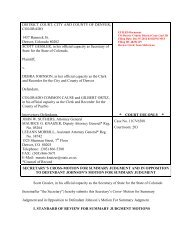
![Download the Letter [PDF] - Brennan Center for Justice](https://img.yumpu.com/50139248/1/190x245/download-the-letter-pdf-brennan-center-for-justice.jpg?quality=85)
